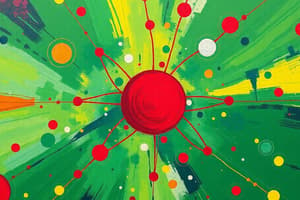Podcast
Questions and Answers
Which of the following best describes the relationship between protons and neutrons in an atom?
Which of the following best describes the relationship between protons and neutrons in an atom?
- Protons and neutrons always have the same number in an atom.
- Protons determine the element, while neutrons influence its isotope. (correct)
- Protons are positively charged particles, while neutrons have no charge. (correct)
- Protons and neutrons are both found in the electron cloud surrounding the nucleus.
What is the main difference between an atom and an ion?
What is the main difference between an atom and an ion?
- An atom can be found in a solid, liquid, or gas, while an ion can only be found in a liquid.
- An ion is a neutral atom, while an atom is a charged atom.
- An atom always has a positive charge, while an ion can have either a positive or negative charge.
- An atom has a stable number of electrons, while an ion has gained or lost electrons. (correct)
How many electrons can the third energy level of an atom hold, according to the Bohr model?
How many electrons can the third energy level of an atom hold, according to the Bohr model?
- 2
- 18
- 32
- 8 (correct)
What is the mass of a single electron in atomic mass units (a.m.u.)?
What is the mass of a single electron in atomic mass units (a.m.u.)?
Which of the following is NOT true about isotopes?
Which of the following is NOT true about isotopes?
Flashcards
Atom
Atom
The smallest unit of an element, making up all matter.
Proton
Proton
A positively charged particle found in the nucleus with a mass of 1 a.m.u.
Electron
Electron
A negatively charged particle located in the electron cloud with a very small mass.
Ion
Ion
Signup and view all the flashcards
Isotope
Isotope
Signup and view all the flashcards
Study Notes
Atomic Structure
- Atoms are the smallest part of an element and make up all matter.
- Atoms are composed of three subatomic particles: protons, neutrons, and electrons.
- Protons have a mass of 1 atomic mass unit (a.m.u.) and a positive charge (+1). They are located in the nucleus.
- Neutrons have a mass of 1 a.m.u. and no charge. They are also located in the nucleus.
- Electrons have a mass of 1/1836 a.m.u. and a negative charge (-1). They are found in the electron cloud surrounding the nucleus.
- Atoms of the same element have the same number of protons.
- Ions are charged atoms that have lost or gained electrons.
- Isotopes are atoms of the same element that have a different number of neutrons.
- The Bohr model shows electrons orbiting the nucleus in energy levels.
- The first energy level can hold two electrons.
- The next two energy levels can hold eight electrons each.
Studying That Suits You
Use AI to generate personalized quizzes and flashcards to suit your learning preferences.




